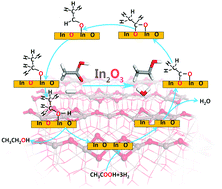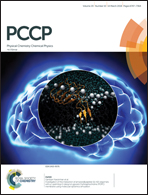Effect of surface oxygen vacancy sites on ethanol synthesis from acetic acid hydrogenation on a defective In2O3(110) surface
Abstract
Developing a new type of low-cost and high-efficiency non-noble metal catalyst is beneficial for industrially massive synthesis of alcohols from carboxylic acids which can be obtained from renewable biomass. In this work, the effect of active oxygen vacancies on ethanol synthesis from acetic acid hydrogenation over defective In2O3(110) surfaces has been studied using periodic density functional theory (DFT) calculations. The relative stabilities of six surface oxygen vacancies from Ov1 to Ov6 on the In2O3(110) surface were compared. D1 and D4 surfaces with respective Ov1 and Ov4 oxygen vacancies were chosen to map out the reaction paths from acetic acid to ethanol. A reaction cycle mechanism between the perfect and defective states of the In2O3 surface was found to catalyze the formation of ethanol from acetic acid hydrogenation. By H2 reduction the oxygen vacancies on the In2O3 surface play key roles in promoting CH3COO* hydrogenation and C–O bond breaking in acetic acid hydrogenation. The acetic acid, in turn, benefits the creation of oxygen vacancies, while the C–O bond breaking of acetic acid refills the oxygen vacancy and, thereby, sustains the catalytic cycle. The In2O3 based catalysts were shown to be advantageous over traditional noble metal catalysts in this paper by theoretical analysis.



 Please wait while we load your content...
Please wait while we load your content...